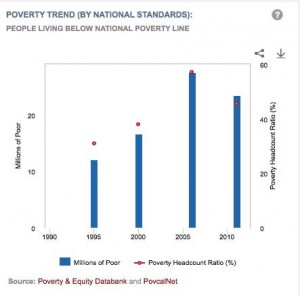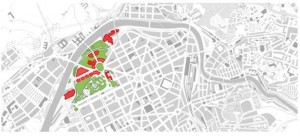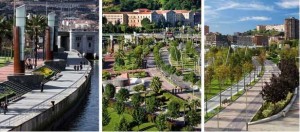“Sustainable development is development that meets the needs of the present without compromising the ability of future generations to meet their own needs” (WCED). It is necessary for people to be mindful towards preserving the planet’s natural resources with not only people alive today, but future generations of inhabitants. Sustainable development requires people to focus on adjusting their awareness towards using renewable resources in order to not deplete the planet’s natural resources. Sustainable development eliminates large gaps in economic class, pushes toward full employment and allows for affordable access of basic services to South Africans, thus leading to reliable and safe communities.
South Africa’s population relies heavily on extracting industries that deplete the environment’s existing natural resources. Extracting industries hinder South Africa’s ability to grow economically and in order to achieve economic development; a country’s population must have a constant expansion in their economic standard of living. South Africa is experiencing detrimental rates of unemployment and poverty, where approximately half of the population falls below the poverty line. In South Africa, those living in a moderate poverty level are estimated to live on 28.71 Rand (2 Euros) per day, while those in extreme poverty conditions live on 14.35 Rand (1 Euro) per day or less.
The South African Government will have a significant role in pushing the entire population into a sustainable and economically thriving country. The Government can ensure growth in sustainable development by creating taxes and regulations that both limit the capabilities of non-sustainable industries, and encourage and reward industries that are sustainable. If the government were to enforce a tax on a non-sustainable practice, such as gasoline, over time the public will become less inclined to drive, or out of convenience be coerced into finding renewable resources to fill the place of a natural resource. In reverse, the Government can cut taxes on sustainable industries that actively operate with the goal of environmental sustainability in mind. To further encourage all practices to function in a sustainable way, government funding can serve as a valuable and motivating incentive for companies to create or update sustainable projects. In order to promote the creation of new sustainable ideas by the public, it is necessary that proper environmental education is provided to every community, so that people across the country are aware and conscious of how each environmental problem will directly affect their daily lives and their country in its entirety. This increased amount of country-wide recognition and acceptance of environmental issues will maximize the potential for regions of South Africa to generate profitable and beneficial ideas for sustainable development. The demand for education of important environmental issues exists in all economic classes. Due to the current extreme gaps of wealth in South Africa, it is essential that the government fulfills its duty of providing proper environmental services to the public, especially in poverty stricken areas that are the most affected by the lack of basic functioning environmental services. The state of the environment significantly affects locations of South Africa flooded with extreme levels of poverty because the poorer people in a society become the group that is most dependent on the natural resources provided to them. Therefore when these natural resources start to diminish and deplete, this massive portion of the country’s population that reside in impoverished conditions will be the group that suffers the most as they lose the resources that are freely provided to them.
With the government serving as the starting point and financial backing for potential sustainable developments, the responsibility of executing any urban regeneration proposals falls into the hands of capable professionals. Architects and urban designers will be responsible for a major role in this direction and will have an opportunity to direct and influence practical and dynamic solutions, and to create sustainable urban architectural proposals. However, they do not work alone in developing these plans. It is necessary to educate communities and involve all the relevant and potential role players into working together to establish a working model that addresses all the vital issues.
Workshops and think tanks involving these role players would prove to be a positive and useful vehicle. The architects need to engage in a proactive dialogue with developers, urban planners, engineers, local authorities, and politicians. Financial institutions need to be engaged at this early stage to ensure that from a financial structuring point of view, they understand the dynamics of development and the long term benefits that can be achieved. This opportunity for open communication amongst key role players will ensure that each contributing area to a development project understands the environmental risks, and the long term economic rewards of sustainable developments. The potential topics to be discussed and investigated at these workshops should be: practical solutions to sustainable design, technology, incorporation and regeneration of existing assets, infrastructure requirements, community involvement and social awareness, creation of eco-friendly environments, use of natural energy sources, financial solutions and cost effectiveness. “In the end, sustainable architecture and urbanism require leadership, political commitment, design, money, open minds, and patience” (Clarke 2012). Urban regeneration and sustainable development plans have been on the drawing boards of architects for some time and it is becoming more and more apart of the design culture that architects need to learn.
A society that is environmentally conscious and understands the long-term benefits of sustainable development can push for and be open minded to urban regeneration and environmental sustainability with a profitable economic result. Societies must be mindful of future generations and what will be left for them. When considering how many individuals and organizations are involved in sustainable developments, the need for proactive communication amongst all role players is evident.
To achieve environmental sustainability in the building sector, architects must be educated about environmental issues during their professional training. Faculties have to foster environmental awareness, introduce students to environmental awareness, introduce students to environmental ethic, and develop their skills and knowledge-base in sustainable design. The current status of sustainable design in architecture is that of an ethic rather than a science. While a change of lifestyles and attitudes toward the local and global environment is important, the development of scientific knowledge bases that provide skills, techniques, and methods of implementing specific environmental design goals is urgent. To enhance environment sustainability, a building must holistically balanced and integrate all three principles – Sustainable Design, Economy of Resources, and Life Cycle Design – in design, construction, operation and maintenance, and recycling and reuse of architectural resources. These principles comprise a conceptual framework for sustainable architectural design. This framework is intended to help designers seek solutions rather than giving them a set of solutions. Specific design solutions compatible with a given design problem will emanate from these principles. In addition to acknowledging the environmental sustainability that must exist in new developments, it is necessary to also acknowledge the economic and social sustainability. Any development must benefit the society and be widely accepted, but a project cannot be successful if it is not economically stable and profitable.
In Bilbao, Spain, large-scale urban design is represented through the Abandoibarra Master Plan and Iberdrola projects starting in 1993. These projects are a successful representation of the goals of a functioning sustainable plan through urban regeneration, economic development and environmental sustainability. The Abandoibarra Master Plan and Iberdola Tower projects are centered on the concepts of environmental sustainability and community involvement. The city of Bilbao was previously an industrial port, with the city’s economy based in manufacturing. As the manufacturing industry began to diminish, public interest was generated in funding facilities to benefit the community.
“The site, which drops 16- meteres between the city and the river, is covered by a concrete platform topped by a public park. Streets and parking are underneath allowing city dwellers to walk to the river’s edge unimpeded. A riverfront promenade connects the Guggenheim Bilbao to the new development” (Clarke 2012).
To conclude, the role of the architect in cooperation with other professionals in areas of work regarding urban regeneration and sustainable development within each country is a role that will require a consistent level of responsibility. Due to the rapidly changing environment, professionals will need to remain up to date with all environmental needs and risks in areas of the world, and be able to work together to address any potential issues in sustainability, and additionally confront society in order to formulate the right solutions. As the planet’s natural resources continue to become scarce, the demand for sustainable developments is significantly increasing. Therefore, all professionals involved in sustainable development projects must shift their thinking to first consider the potential environmental risks of each project and the possible ways of making it a sustainable plan.
References:
Bilbao International. Abandoibarra [Photographs]. Retrieved from http://www.bilbaointernational.com/en/abandoibarra/
Clarke, F.W. (2012). The architect’s role in urban regeneration, economic development, and environmental sustainability. Retrieved from .http://pcparch.com/firm/bibliography/essays/the-architect-s-role-in-urban-regeneration-economic-development-and-sustainability
Poverty and Equity Bank. Poverty trend by national standards [Graph]. (2013). Retrieved from http://povertydata.worldbank.org/poverty/country/ZAF
Thwala, W.D. (2009). Sustainable development through urban renewal projects. [Technical Report]. Retrieved from https://ujdigispace.uj.ac.za/bitstream/handle/10210/5311/Wellington.pdf?sequence=1&isAllowed=y
World Bank. (November 2014). South Africa economic update: fiscal policy and redistribution in an unequal society. Retrieved from http://www.worldbank.org/en/country/southafrica/publication/south-africa-economic-update-fiscal-policy-redistribution-unequal-society
World Commission on Environment and Development. (1987). What is sustainable development. Retrieved from https://www.iisd.org/sd/



